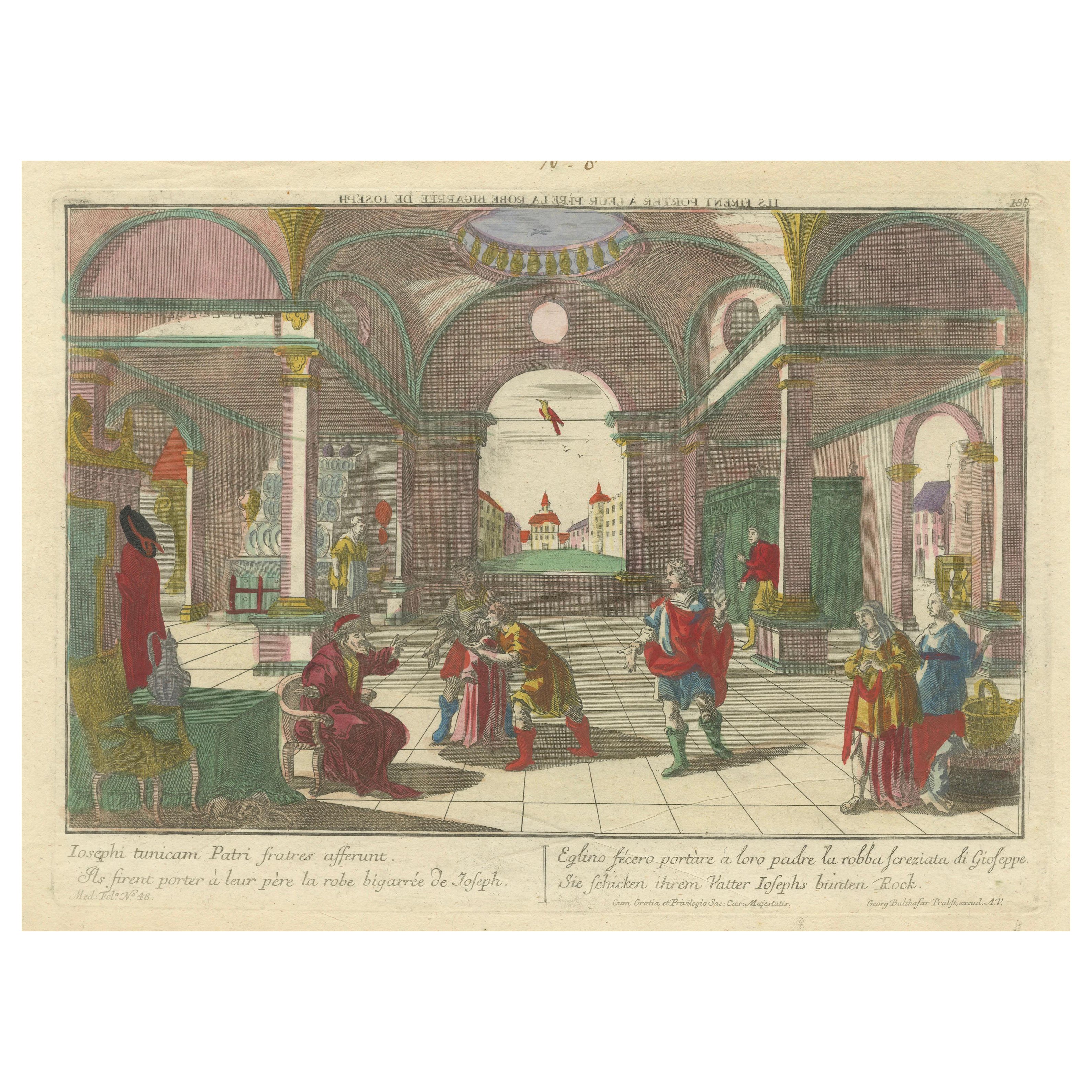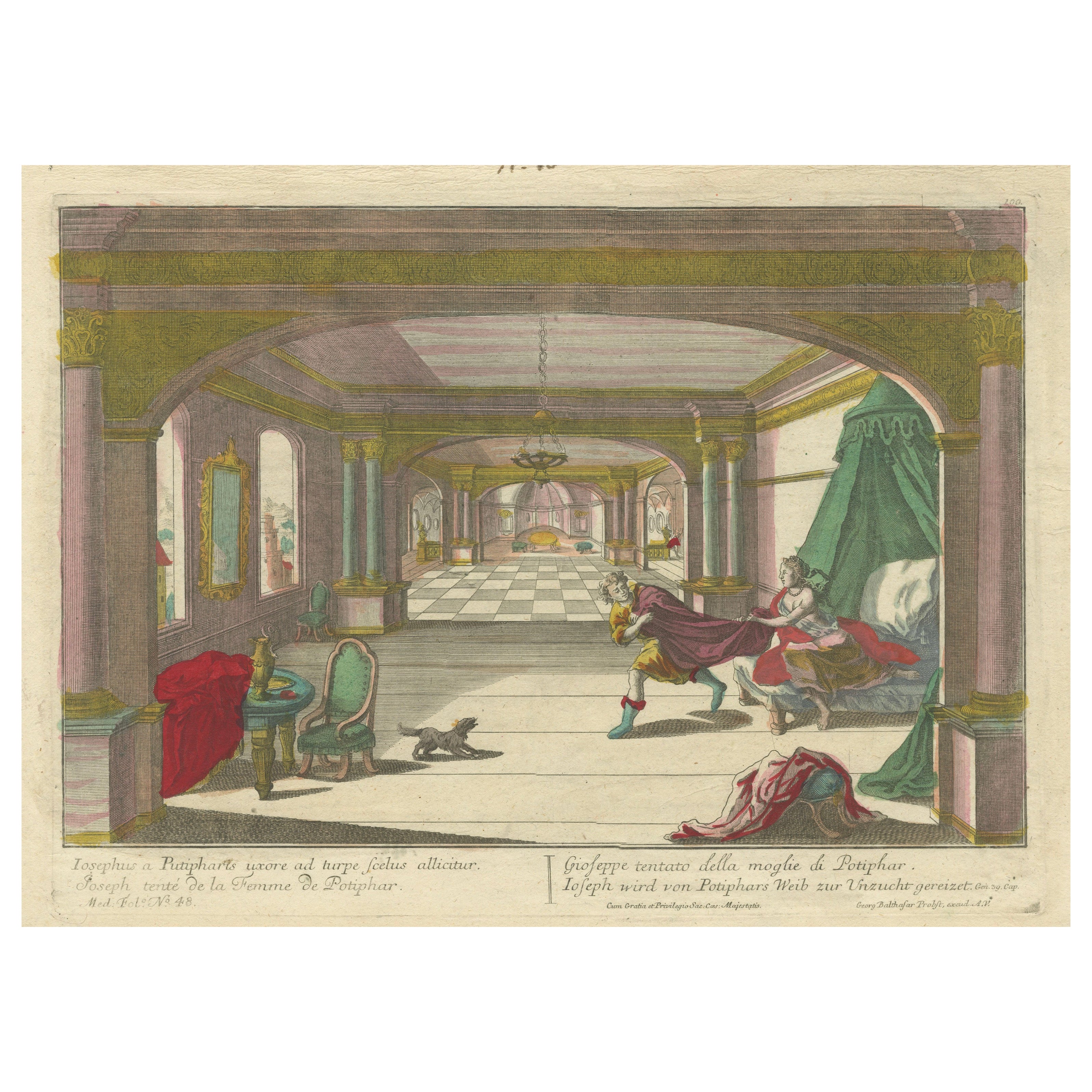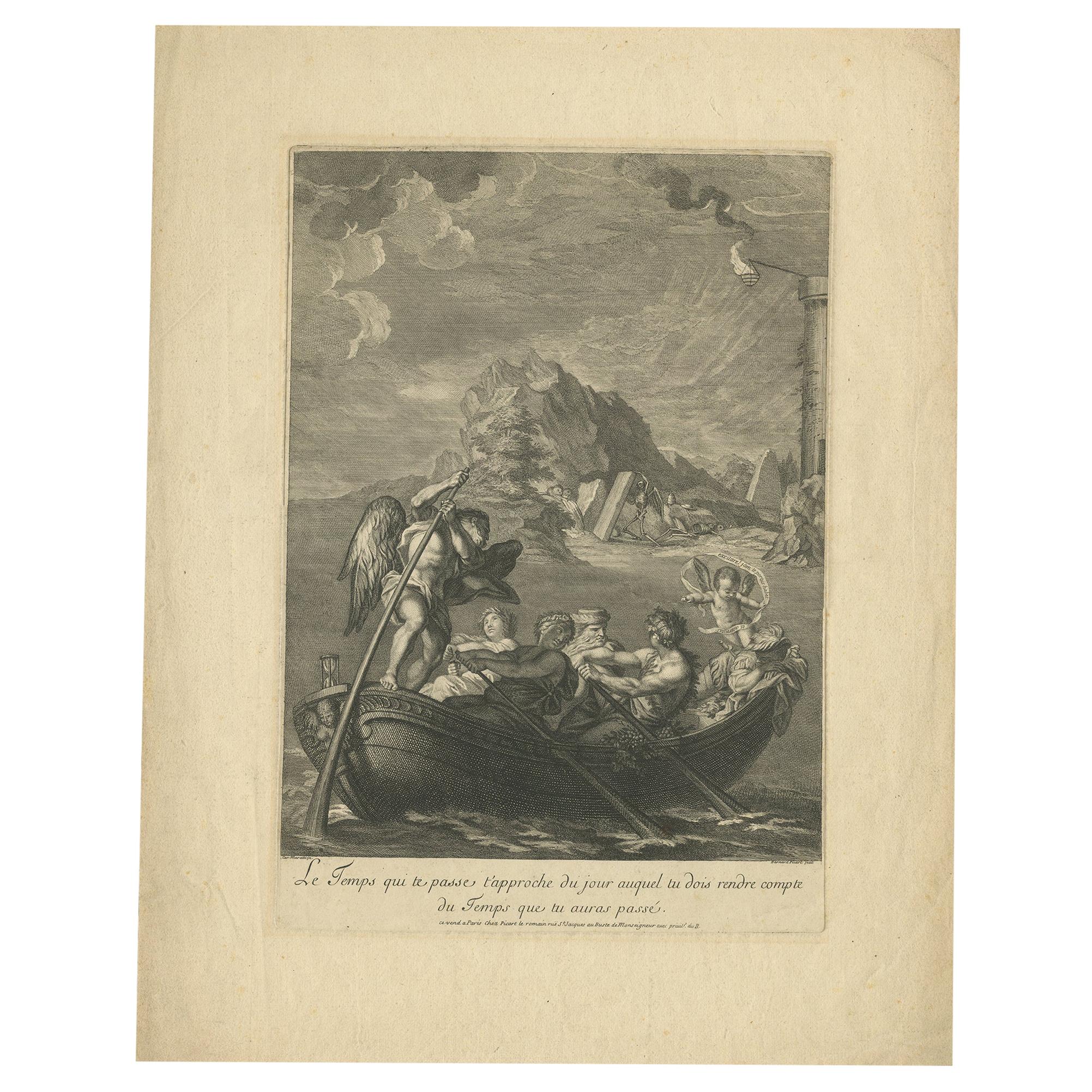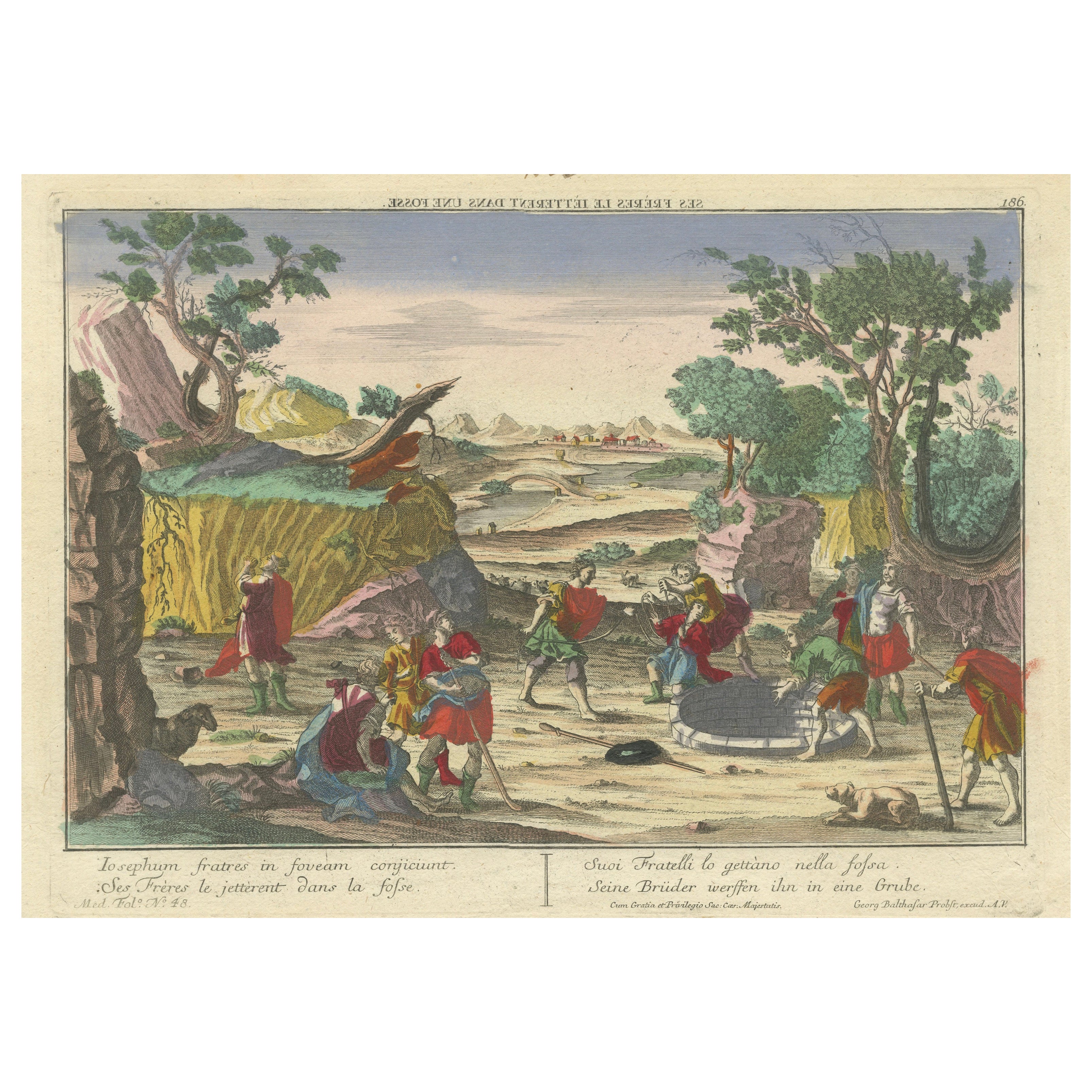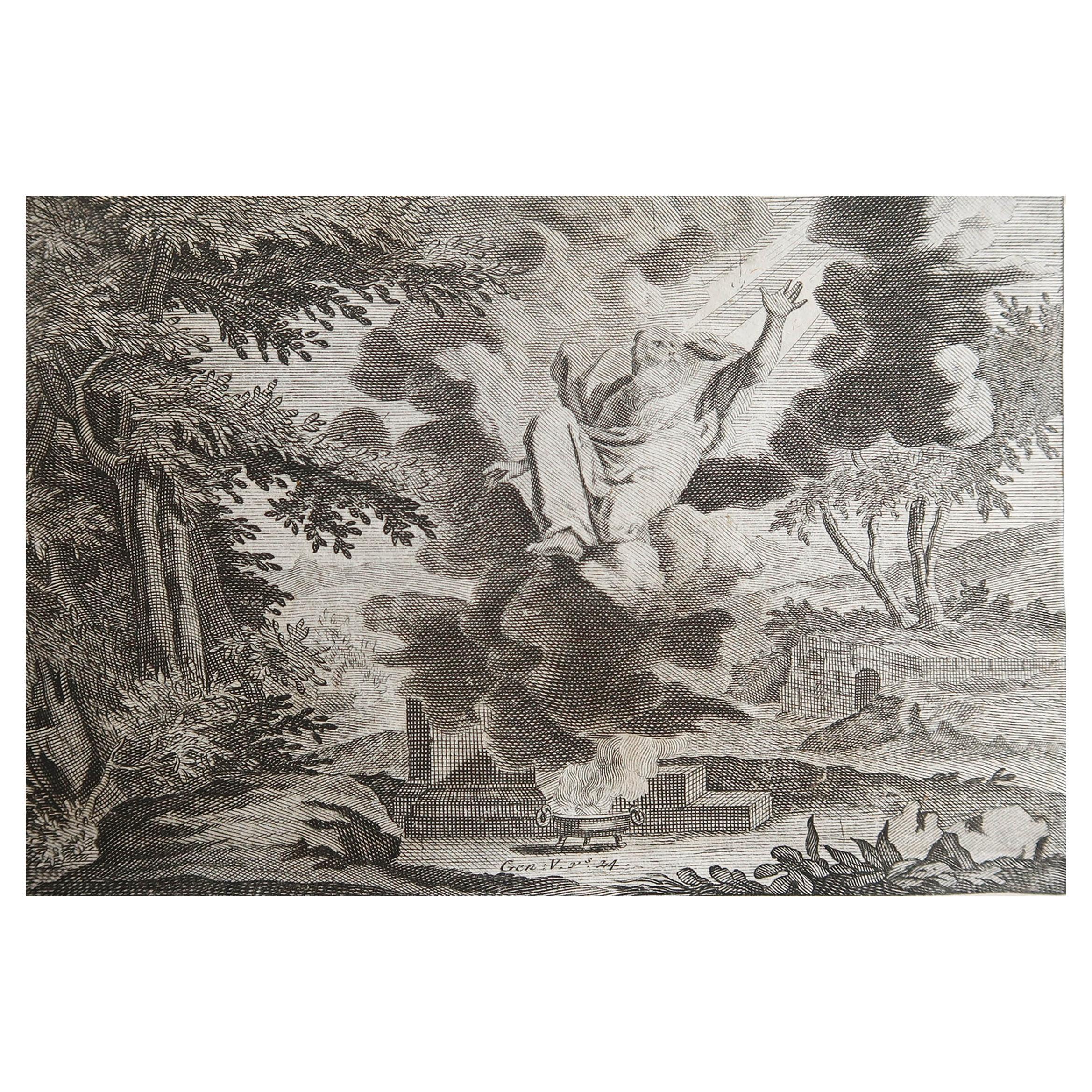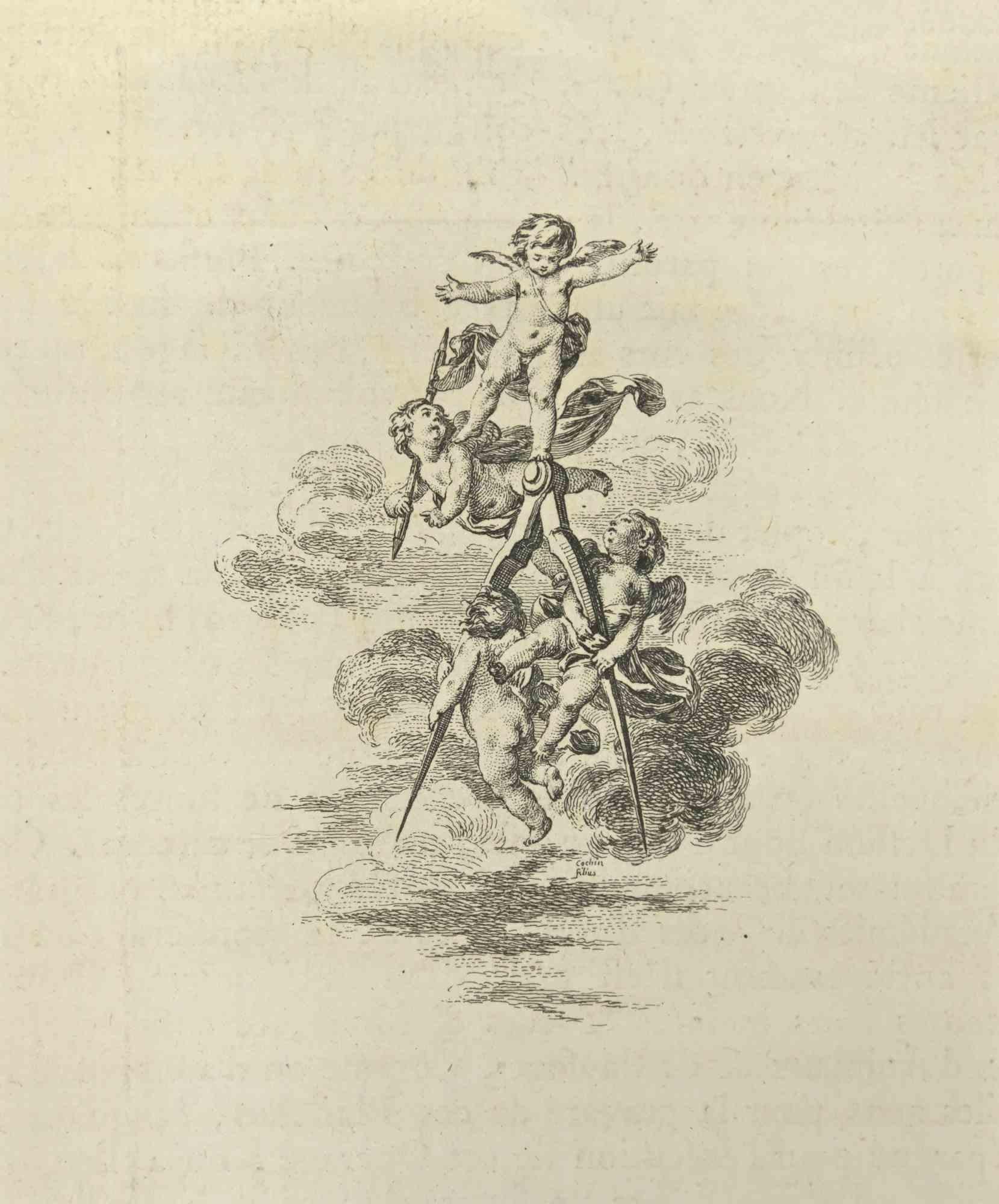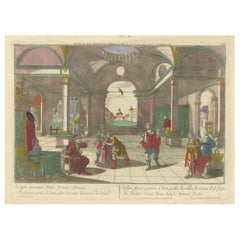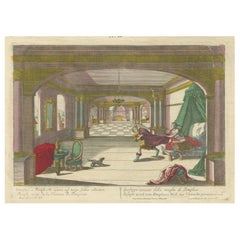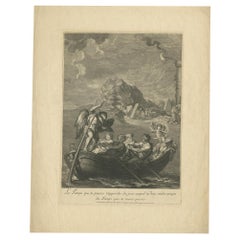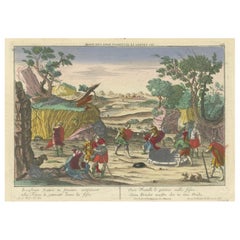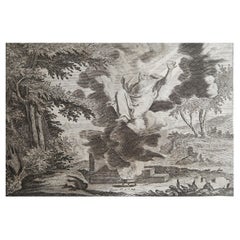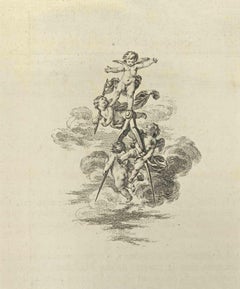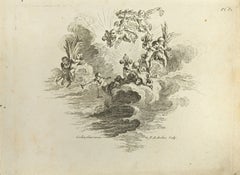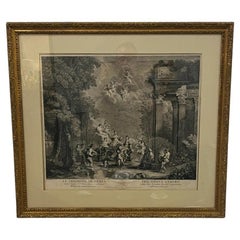Articles similaires à Optical Print of Aeolus, God of Winds – Allegory of Air, circa 1760
Chargement de la vidéo
Vous voulez plus d'images ou de vidéos ?
Demander au vendeur plus d'images ou de vidéos
1 sur 11
Optical Print of Aeolus, God of Winds – Allegory of Air, circa 1760
390 €TVA incluse
À propos de cet article
Allegory of the Air – 18th Century Optical Print after Burnacini
This vibrant and theatrical 18th-century optical print presents an allegorical representation of 'Air', rendered with striking hand-coloring to enhance its depth and visual impact when viewed through an optical viewing box.
Engraved by Tobias Lobeck and based on a design by Lodovico Ottavio Burnacini (1636–1707), a renowned Italian stage designer, the print is a captivating synthesis of classical mythology and baroque scenography.
The composition shows a dramatic grotto interior, with richly colored rocky walls curving upward in a dome-like formation. At the center sits a regal figure—Aeolus, the god of the winds—enthroned and commanding the scene. Flanking him are winged wind spirits energetically exhaling gusts of air, their motion frozen in dynamic postures. Hovering above the entire spectacle is a female figure draped in vibrant garments, standing upon a swirling cloud. This theatrical vision echoes Burnacini’s background in stage and set design, where the blending of allegory, movement, and color was key to the baroque spectacle.
The print bears the title in four languages—German (Die Luft), Latin (Aer), French (L’Air), and Italian (L’Aria)—followed by a verse referencing Book I of Virgil’s *Aeneid*, where Juno appeals to Aeolus to release the winds in order to punish the Trojans. This cross-lingual and literary framing underscores the print’s Enlightenment-era role in both education and entertainment.
The publication line identifies Tobias Lobeck as engraver, and credits Burnacini as designer. The print was issued with the privilege of the Holy Roman Emperor by the Imperial Academy in Augsburg (Negotium Academiae Caes. Francisceae excudit Aug. Vind.), a key center for such optical and theatrical prints in the 1700s.
Condition summary:
Well-preserved with bright original hand-coloring. Minor toning to the margins and faint signs of handling, but no major flaws. Rich detail remains intact and colors are striking. Small remains of tape on the borders of the reverse. Patina rich optica print.
Framing tips:
Frame with a gold or black moulding and a soft cream mat to emphasize the vivid colors. Use museum glass to preserve detail and reduce glare. Ideal for a library, hallway, or collector’s wall of curiosities.
This optical print was published in the 18th century, most likely between 1740 and 1780, when Tobias Lobeck was active in Augsburg. While no exact year is printed on the sheet, it was issued by the Imperial Franciscan Academy (Academiae Caes. Francisceae) with imperial privilege, placing it firmly within that mid-18th-century context.
Tobias Lobeck’s collaboration with designs by Lodovico Ottavio Burnacini, who died in 1707, also supports this dating, as Burnacini’s theatrical designs were frequently adapted and engraved posthumously in the mid-1700s for optical prints and stage scenes popular throughout Europe.
- Dimensions:Hauteur : 30,3 cm (11,93 po)Largeur : 43,5 cm (17,13 po)Profondeur : 0,2 mm (0,01 po)
- Matériaux et techniques:Papier,Gravé
- Période:1760-1769
- Date de fabrication:circa 1760
- État:Well-preserved with bright original hand-coloring. Minor toning to the margins and faint signs of handling, but no major flaws. Rich detail remains intact and colors are striking. Small remains of tape on the borders of the reverse.
- Adresse du vendeur:Langweer, NL
- Numéro de référence:Vendeur : BG-14083-11stDibs : LU3054345434512
À propos du vendeur
5,0
Vendeur reconnu
Ces vendeurs prestigieux sont des leaders du secteur. Ils représentent le summum en matière de qualité et de design.
Vendeur Platine
Vendeurs premium dont la note est supérieure à 4,7 et le délai de réponse de 24 heures maximum
Établi en 2009
Vendeur 1stDibs depuis 2017
2 567 ventes sur 1stDibs
Temps de réponse habituel : <1 heure
- ExpéditionRecherche du devis...Expédition depuis : Langweer, Pays-Bas
- Politique des retours
Certaines parties de cette page ont été traduites automatiquement. 1stDibs ne garantit pas l'exactitude des traductions. L'anglais est la langue par défaut de ce site web.
Garantie d'authenticité
Bien qu'il soit peu probable que la situation se présente, dans le cas où vous rencontreriez un problème d'authenticité d'un article, contactez-nous dans un délai d'un an pour obtenir un remboursement intégral. DétailsGarantie de remboursement
Si votre article n'est pas conforme à la description, est endommagé pendant le transport ou ne vous est pas livré, contactez-nous sous 7 jours pour obtenir un remboursement intégral. DétailsAnnulation sous 24 heures
Vous disposez d'un délai de 24 heures pour annuler votre achat sans motif.Des vendeurs professionnels agréés
Nos vendeurs de renommée mondiale doivent respecter des normes strictes en matière de service et de qualité, afin de préserver l'intégrité de nos fiches produit.Garantie d'alignement des prix
Si vous constatez qu'un autre vendeur a mis en vente le même article à un prix inférieur sur un autre site, nous nous alignerons sur ce prix.Livraison en toute confiance à l'international
Notre réseau de transporteurs de premier ordre propose des options d'expédition spécialisées dans le monde entier, y compris des livraisons personnalisées.Plus d'articles de ce vendeur
Tout afficherGravure optique de la robe de Joseph montrée à Jacob, 1770 - Scène biblique coloriée à la main
Épreuve d'optique de la robe de Joseph montrée à Jacob, vers 1770 - Scène biblique architecturale coloriée à la main
Cette élégante vue d'optique du XVIIIe siècle intitulée "Josephi...
Catégorie
Antiquités, Milieu du XVIIIe siècle, Allemand, Estampes
Matériaux
Papier
Gravure optique de Joseph tenté par la femme de Potiphar, 1770 - Scène biblique dramatique
Gravure optique de Joseph tenté par la femme de Potiphar, vers 1770 - Vue d'Optique dramatique colorée à la main par Probst
Cette vue d'optique colorée à la main, intitulée "Josephu...
Catégorie
Antiquités, Milieu du XVIIIe siècle, Allemand, Estampes
Matériaux
Papier
Estampe ancienne de l'Allégorie du temps par Picart:: vers 1720
Gravure ancienne intitulée 'Le Temps qui te passe t'approche du jour auquel tu dois rendre compte du Temps que tu auras passé'. Gravure sur cuivre de l'Allégorie du temps. Elle montr...
Catégorie
Antiquités, Début du XVIIIe siècle, Estampes
Matériaux
Papier
360 € Prix de vente
20 % de remise
Gravure optique de Joseph jeté dans une fosse par ses frères, 1770 - Scène biblique
Gravure optique de Joseph jeté dans la fosse par ses frères, vers 1770 - Vue d'Optique d'Augsbourg coloriée à la main
Cette gravure spectaculaire colorée à la main est une authentiq...
Catégorie
Antiquités, Milieu du XVIIIe siècle, Allemand, Estampes
Matériaux
Papier
Impression ancienne Mercure descendant sur terre d'après une fresque de Raphaël:: 1693
Gravure ancienne intitulée "Mercurius uocalis Deus ex Louis mandato Deos omnes ad concionem conuocat de Cupidinis ac Psyches coniugio sententiam laturi". Mercure descendant vers la t...
Catégorie
Antiquités, Fin du XVIIe siècle, Estampes
Matériaux
Papier
2 000 € Prix de vente
20 % de remise
Estampe optique de Joseph racontant son rêve à ses frères, 1770 - Scène biblique
Gravure optique de Joseph racontant son rêve à ses frères, vers 1770 - Scène biblique coloriée à la main
Cette captivante estampe ancienne coloriée à la main est un exemple exceptio...
Catégorie
Antiquités, Milieu du XVIIIe siècle, Allemand, Estampes
Matériaux
Papier
Suggestions
Impression d'origine ancienne d'après Jan Luyken, Amsterdam, Genesis V, 1724
Magnifique gravure sur cuivre d'après Jan Luyken
Publié par Marten Schagen, Amsterdam. 1724
Texte au verso
La mesure indiquée correspond au format du papier.
Catégorie
Antiquités, années 1720, Néerlandais, Renaissance, Estampes
Matériaux
Papier
Des Anges - Gravure de Nicholas Cochin - 1755
Angels est une gravure réalisée par Nicholas Cochin en 1755.
Bonnes conditions.
La gravure a été réalisée pour l'étude d'anatomie "JOMBERT, Charles-Antoine (1712-1784) - Méthode po...
Catégorie
années 1750, Surréalisme, Estampes - Figuratif
Matériaux
Eau-forte
Des Anges - Gravure de Nicholas Cochin - 1755
Angels est une gravure réalisée par Nicholas Cochin en 1755.
Bon état avec de légères rousseurs et des marges vieillies.
Signée sur la plaque.
La gravure a été réalisée pour l'étu...
Catégorie
années 1750, Moderne, Estampes - Figuratif
Matériaux
Eau-forte
Gravure du 18e siècle "The Triumph De Ceres" (Le triomphe de Cérès)
Le Triomphe de Cérès gravure de Louis Crepy d'après Jean-Antoine Watteau. Inscription de Watteau en bas à gauche et inscription de Crepy à droite. Gravure française du début des anné...
Catégorie
Antiquités, Début du XVIIIe siècle, Français, Autre, Estampes
Matériaux
Papier
Impression originale ancienne d'après Jan Luyken, Amsterdam, Genesis XXII. 1724
Magnifique gravure sur cuivre d'après Jan Luyken
Publié par Marten Schagen, Amsterdam. 1724
Texte au verso
La mesure indiquée correspond au format du papier.
Catégorie
Antiquités, années 1720, Néerlandais, Renaissance, Estampes
Matériaux
Papier
30 €
Livraison gratuite
Scène romaine antique - gravure - XVIIIe siècle
Scène romaine antique de la série "Antiquités d'Herculanum", est une gravure sur papier réalisée par Niccolò Vanni au XVIIIe siècle.
Signé sur la pl...
Catégorie
Fin du XVIIIe siècle, Maîtres anciens, Estampes - Figuratif
Matériaux
Eau-forte
